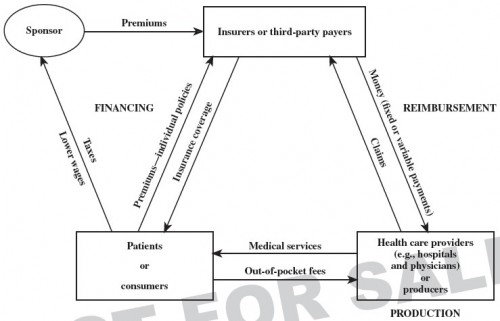Chapter 4 of Health Economics: Theories, Insights, and Industries Studies, by Santerre and Neun includes the following conceptual model of our health system.
About this figure, one thing the authors write is:
For a typical market transaction, the individual consumer and producer are the only ones involved in the exchange as shown in the bottom flow of the diagram. In that instance, the consumer’s out-of-pocket price equals the full cost of the service provided. Buyer and seller are equally well informed, and the buyer pays the seller directly for the good or service. For example, the purchase of a loaf of bread at a local convenience store involves a normal market transaction. Both consumer and seller have the same information regarding the price and quality of the bread, and the transaction is anticipated and planned by the consumer. An unexpected outcome is not likely to occur, and, if it did, it could be easily rectified (for example, stale bread can be easily returned).
In a medical market, the corresponding situation is a prespecified patient fee paid directly to a doctor or a hospital for some predetermined and expected quantity and quality of medical services. In the case of medical services, however, the transaction is often not anticipated, and the price, quantity, and quality of medical services are unknown until after the medical event occurs. The transaction is unanticipated because medical illnesses occur irregularly and unexpectedly (Arrow, 1963). The price, quality, and quantity of medical services are not known initially because much uncertainty surrounds the diagnosis and proper treatment of a medical problem. In addition, health care providers possess a greater amount of information relative to patients regarding the provision of medical services, giving rise to an asymmetry of information. Because no simple relation exists between diagnosis and treatment, and much is left to the discretion of health care providers, possibilities for opportunistic behavior arise. That is, health care providers may produce more treatments or a higher-quality treatment than economic considerations warrant.
I’ll note that there is basically no way to fully reduce the conceptual model of the health care system to that of a “typical market transaction,” which is depicted in the bottom flow (lowest two boxes) of the diagram. Sure, one can change the relative size of the money flows (arrows), but nobody is proposing to do away with sponsors (agents, employers or regulatory bodies) or third-party payers. Of course it is theoretically possible to remove sponsors and third-party payers from health care. Short of an apocalypse, it will never happen.
Nor should it. Sponsors and third-party payers actually play valuable roles in mitigating some of the detrimental ways in which health care markets fail to be like that for other goods.
References
Arrow, Kenneth J. “Uncertainty and the Welfare Economics of Medical Care.” American Economic Review 53 (December 1963), pp. 941–73.



